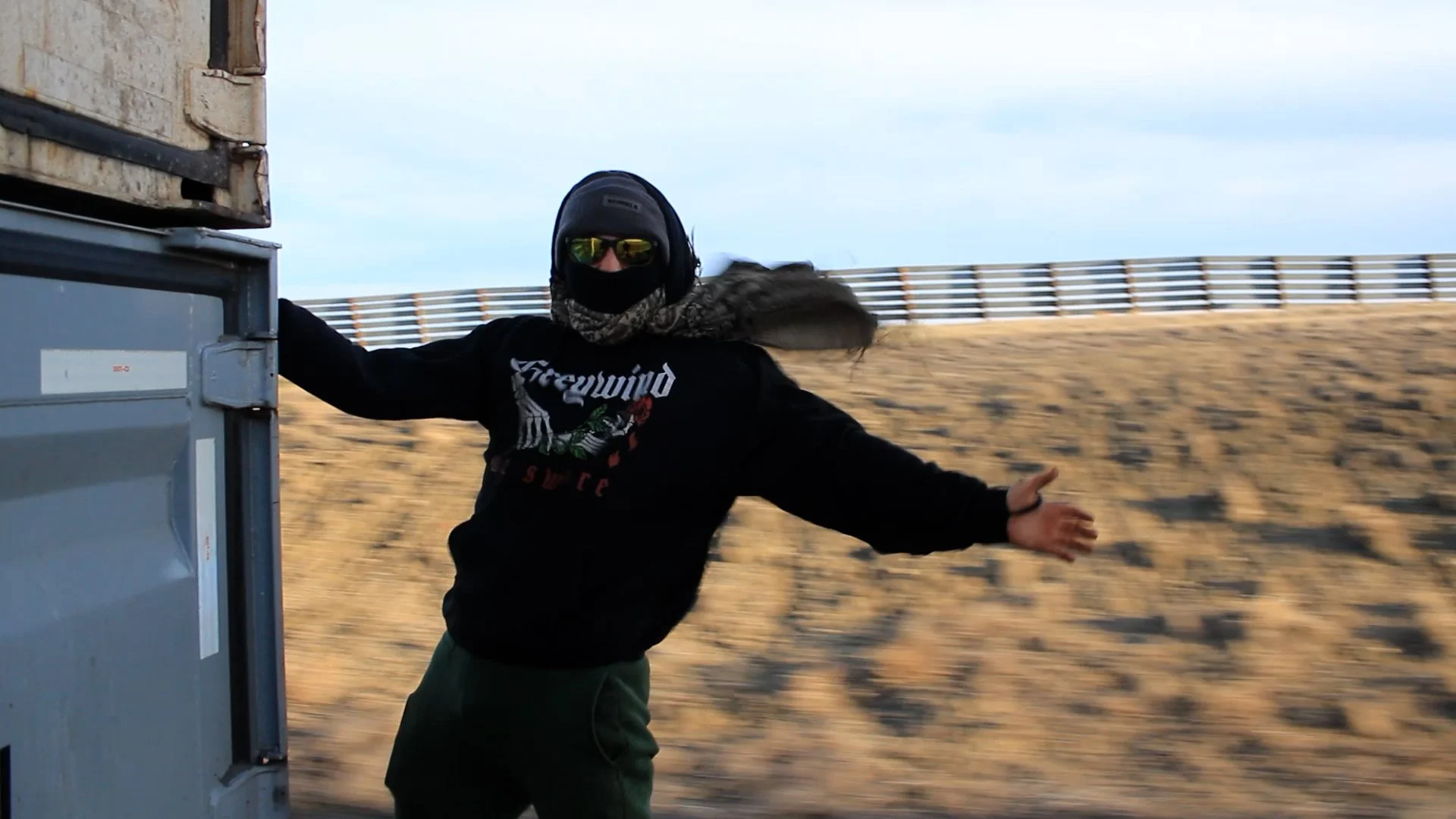HIGHLINE SILENT FILM BLOG
Full Length Film Available Here
This trip came out of necessity. I had plans to meet up with my friend, Night Runner, in Vancouver, Canada. I didn’t want to buy a plane ticket, so I figured, why not take the scenic route? I hit up my buddy Warden Wanders, whom I had met during the filming of “Ocean to Desert Part Two”. During that time, we explored abandoned places together and drove around Kansas City. At first, I was skeptical about the route—The Highline—one that my friends Dancer and Bito had taken the summer before. I had planned to join them on that trip, but responsibilities back in Chicago kept me grounded. I did, however, join them for the New York to Chicago stretch, which you can see in Bito’s video “Train Hopping Across America”, as well as my video “Train Hopping the Appalachian Mountains”.
I met Warden near the yard where we had planned to hop out. I’d scoped it out in the past and knew the best waiting spot, so we made our way to an underpass. Trains are notorious for flying out of this yard fast, going around 10- 15mph. I warned him about that, but didn’t give him the full rundown on how to catch on the fly. The spot we chose was sketchy: lots of rocks, a crossing track, and a wall—if you didn’t catch it in time, you could get seriously hurt. Fortunately, we both made it on. But Warden hit his head tripping over the crossing track, trying to catch on the fly, and ended up with a decent head injury.
As we left Chicago, we were treated to a gorgeous sunset over the Mississippi River, cutting through the Mississippi Palisades—a place I used to railfan growing up. By nightfall, we’d reached Minneapolis, our first crew change spot. Minneapolis is notorious for a bull who actively patrols the yard, and by the time we rolled in, I was well through my collection of alcohol. I figured if we stayed well hidden under the grate, we wouldn’t have an issue sneaking through. I had tried hopping out of this same yard a year before with my friend Hayden, where we waited three days in a mosquito-infested patch of bushes before he finally caught out. I, however, had to give up and fly to Seattle to meet up with Dancer and Anya for a trip to Alaska. Because of that experience, I was determined not to get off the train unless we had to. We rode through the city in the night and woke up in Fargo, North Dakota, the next morning.
Fargo is another crew change stop along the Highline—not much to it other than open plains and endless visibility. Honestly, most of the Highline isn’t particularly scenic. It’s a desolate landscape filled with dead grass for hundreds of miles, the good stretch of it being right after Minneapolis to about Glacier National Park. Toward the very end, however, the route becomes one of the most beautiful stretches of rail in the entire country. One redeeming feature of the plains is the stunning sunrises and sunsets. With nothing on the horizon, you get an unobstructed view of the sky, painted in rich, vibrant colors.
After Fargo, we high-tailed it across North Dakota until we reached Glasgow, Montana. Most of this, we rode through a rainstorm, hiding under the grate, trying to stay dry. Reaching Glasgow, I remembered that Dancer had told me about a hotel/campsite in town, so we decided to hop off and grab a campsite for the night. While checking in at the hotel lobby, we struck up a conversation with a stranger who happened to be into raves—a scene Warden is deeply involved in. By chance, the guy offered us his hotel room for the night. We went back to the campsite, packed up, and joined him. We drank more than our fair share, passed out, and by the time we woke up, he was gone. Turns out he worked for a brewing company and had to leave early for a drive downstate. With him gone, we had the room to ourselves for a few hours, and it was time to shower, relax, and recharge.
After leaving the hotel, we decided to play it safe and take an Amtrak from Glasgow to Havre. Havre is the most notorious crew change on the Highline—tight security, and if you’re caught, you risk spending up to two weeks in jail. Yard security has a system: golf carts patrol up and down the line, shining flashlights under and between cars, scanning for riders and anything out of place. We wanted to scope things out before committing and attempting to ride into Havre blind. Once in Havre, we took some photos and videos of the Amtrak station and the yard. That evening, we even saw the Minecraft movie in town, just blocks from one of the most secure rail yards in North America. After the movie, we crashed behind a random hotel near the catch-out spot. Exploring the building a bit, we found a whole wing that was completely abandoned—yet pristine. Working electricity, running water, clean beds, and unlocked rooms. We took a quick nap in one of them.
Around 3 a.m., we made our move. We watched security do their rounds in the golf carts, scanning the trains. We scoped out our ride. No perfect setups, but we took the risk and caught a suicide 53 well out of Havre. As we crept slowly out of the yard, I silently prayed the train wouldn’t stop, and that security wouldn’t notice us. I was freezing and exhausted from staying up most of the night. Luckily, we made it out undetected. Once we were clear, I laid down and took a nap in the well car. As dawn broke, we watched the sun rise over the plains—right as we entered what would be the most breathtaking part of the journey.
THE FOLLOWING MORNING AFTER LEAVING HAVRE (PICTURED WARDEN ON THE SIDE OF THE TRAIN)
The mountains of Glacier National Park began to rise in the distance, and we were floored by the view. This, after all, was the most scenic stretch of the Highline—the very reason we had ridden all this way. From Glacier all the way to Seattle, the scenery is unmatched. Without question, it’s one of the most beautiful stretches of track in the entire country. As the peaks loomed larger, we put on some music and passed around a bottle of Captain Morgan, caught up in pure ecstasy. The train wound like a serpent through mountains still capped with spring snow, slipping through avalanche tunnels and tracing the paths of rivers whose rushing water sounded like a living symphony. Growing up in the Midwest, I could hardly believe landscapes like this even existed. It reminded me why I put myself through all the blood, sweat, and risk—dodging security, gambling with safety. We were seeing places most people only dream about. After a few hours, we rolled out of Glacier and toward Whitefish, Montana. We had planned to hop off there, camp out, and spend a day swimming at Whitefish Lake. But I had misunderstood the crew change stop. Expecting the train to stop near the Amtrak station, we stayed on too long. By the time we realized, the train had already picked up too much speed to bail. Disappointed, we watched the lake slide by as the train carried us further west.
We spent about half a day riding through Glacier, and by the time we passed Whitefish and reached Idaho, the sun was setting. We rolled through the Kootenai National Forest and the Idaho Panhandle at dusk, unfortunately missing another scenic highlight of the Highline—the bridge over Lake Pend Oreille. Around 3 a.m., we reached another crew change stop in Hauser. There’s always a fifty-fifty chance the train will switch crews at either Hauser or Spokane, and we lucked out this time. Hauser was a far easier yard to deal with; Spokane was notorious for being a tough catch-out with an asshole bull. The timing couldn’t have been better either—3 a.m., when the odds of being spotted were slim. From Hauser, we continued west until the line split, one way toward Portland and the other toward Seattle. Thankfully, our train took the Seattle split, and we slept most of the night, waking up as we rolled into Wenatchee by morning. I hadn’t expected a stop there, but we ended up sitting for nearly six hours. I never figured out why trains linger so long in Wenatchee, but we took the chance to stretch our legs, skip rocks on the river, and wait for the ride to get moving again.
Eventually, the train crawled out of Wenatchee, and we stayed low until we were clear of the city. Ahead lay the Cascade Mountains—yet another breathtaking stretch of the ride. As we approached, an almost mythical fog draped itself over the peaks, cloaking the range in mystery. Just like Glacier, we watched in awe as massive monoliths of rock rose before us. Winding through the Cascades carried a strange, almost otherworldly aura. Mist-shrouded mountains surrounded the train as we passed through the eerie but stunning landscape. This was the Pacific Northwest in its purest form. After four days on the Highline, we had finally reached it—rainforest, towering pines, jagged snow-covered peaks. For half a day we snaked through the range before finally breaking free. Beyond the mountains, the last leg of our journey began: riding the coast south from Everett toward Seattle. Out the window, ships moved across the water while people gathered on the beaches. We waved from the train, unbothered and relieved—so close to our destination, almost comforted by the sight of civilization after days in the wilderness.
The ride along the coast felt like a reward for surviving the Highline. Houses dotted the cliffs above the water, and fishermen worked the bay hauling in their catch. But soon the coast gave way to the edge of the city, and the landscape transformed into a concrete jungle. Buildings rose around us, the Space Needle piercing the skyline as we drew closer. We began scanning for a place to bail. When the moment came, it wasn’t easy. Trapped by concrete walls and barbed wire, we spotted a hole in the fence at the last second and jumped. Scrambling through, we found ourselves in a maze of city streets. On the other side, filthy and exhausted, we emerged to stares from strangers who looked at us in shock, wondering what we had been through. We just laughed, brushing it off, and strolled on without a care in the world—our journey finally complete. That evening, we watched the sun set over the harbor near Pike Place, ate real food for the first time in days, and met up with Warden’s friend, who gave us a place to crash. After four long days, the Highline was behind us, and we could finally rest.




